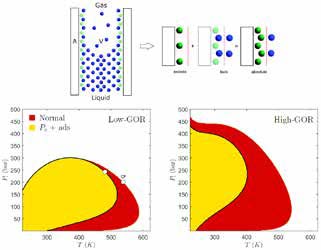The project has developed robust calculation tools for phase equilibrium in porous media with capillary pressure and adsorption effects.
Production of oil and gas from shale reservoirs has become a reality over the past few decades. As shale reservoirs are much tighter than conventional reservoirs, with pore sizes ranging in the nanometer scale, they were previously considered technically unviable to produce. New technologies such as horizontal drilling and multistage fracturing have changed the scene, but forecasting of the production remains a challenging task. The project presents models and algorithms for the purpose.
Especially in USA, production from shale has grown fast and partly substituted electricity from coal-fired power plants. However, current recovery factors are low ranging from 20-30 % for shale gas and 3-7 % for shale oil. A better understanding of the processes involved is likely to lead to higher recovery factors.
The confined nature of shale reservoirs introduces challenges in the understanding of the fluid phase behavior. High capillary forces can be experienced between the liquid and vapor, and selective adsorption of components onto the rock becomes relevant.
The project presents an efficient algorithm for phase envelope calculations in the presence of capillary pressure. It is used to analyze the main changes on the phase boundary for several fluids of interest. The results show changes in the saturation pressure and temperature along the phase envelope, except at the critical point. A linear analysis explains such changes. As a result, useful mathematical relationships that estimate the magnitude of these changes were obtained. Moreover, a flash algorithm that accounts for capillarity was developed.
Since capillary pressure and adsorption occur simultaneously in shale, its combined effect was studied. A model comparison for high-pressure adsorption in shale is presented. As adsorption data in shale are scarce, additional capabilities besides the accuracy were considered. The multicomponent potential theory of adsorption yields the best results. Moreover, it is useful to extrapolate adsorption data for hydrocarbons that are not available in the literature. An algorithm for phase split calculations considering both capillary pressure and adsorption was developed. The results show that adsorption and capillary pressure can significantly change the phase behavior. In general, a shrunk phase envelope with a shifted critical point is obtained for hydrocarbon mixtures. This behavior is mainly caused by compositional changes in the bulk phase due to selective adsorption of the heavier components onto the rock, while the change in bubble point pressure is mainly due to capillary pressure.
In conclusion, the project has developed several robust calculation tools for phase equilibrium in porous media with capillary pressure and adsorption effects. Analysis based on use of these tools shows capillary pressure and adsorption to have non-negligible effects on phase equilibrium in shale.

Illustration:
Effect of capillary pressure and adsorption on phase equilibrium of fluids with different GORs (gas oil ratios)